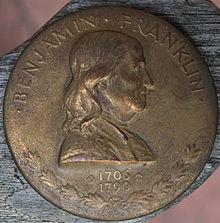Franklin half dollar
The Commission disliked the small eagle and felt that depicting the crack in the Liberty Bell would expose the coinage to jokes and ridicule.[4] In a 1948 interview, Ross noted that Franklin only knew of living royalty on coins, and presumably would feel differently about a republic honoring a deceased founder.[7] During the war, the Mint contemplated adding one or more new denominations of coinage; Sinnock prepared a Franklin design in anticipation of a new issue, which did not occur.[7] Similar to Sinnock's work for the Roosevelt dime, the portrait is designed along simple lines, with Franklin depicted wearing a period suit.The small eagle on the reverse was added as an afterthought, when Mint officials realized that the Coinage Act of 1873 required one to be displayed on all coins of greater value than the dime.[9] The Mint sought comments on the designs from the Commission of Fine Arts, which was provided with a lead striking of the obverse and a view of the reverse; Taxay suggests they were shown a plaster model.On December 1, 1947, Commission chairman Gilmore Clarke wrote to Ross saying that they had no objection to the obverse, in which they recognized Sinnock's "good workmanship".Franklin became the fifth person and first non-president to be honored by the issuance of a regular-issue US coin, after Lincoln, Roosevelt, George Washington and Thomas Jefferson.They were sold from a booth on the steps of the Sub-Treasury Building in New York, by employees of the Franklin Savings Bank dressed in Revolutionary-era garb.Even though Sinnock's initials (placed on the cutoff of Franklin's bust) were expressed "JRS", the Mint still received similar complaints, to which they responded with what numismatic historian Walter Breen termed "outraged official denials".[15] After the assassination of John F. Kennedy on November 22, 1963, Congress and the Mint moved with great speed to authorize and produce a half dollar in tribute to him.[18] Breen reports rumors of 1964 Franklin half dollars, produced possibly as trial strikes to test 1964-dated dies, but none has ever come to light.[19] The Franklin half dollar was struck in relatively small numbers in its first years,[9] as there was limited demand due to a glut of Walking Liberty halves.




US dollarsreededtroy ozPhiladelphia MintBenjamin FranklinJohn R. SinnockLiberty BellGilroy RobertsstruckUnited States Mintfifty-cent pieceFounding Fatherobversereeded edgePhiladelphiaDenverSan FranciscoNellie Tayloe RossCommission of Fine ArtsJoseph StalinRoosevelt DimeKennedy half dollarassassinatedJohn F. Kennedylegal tendernumismaticWalking Liberty half dollarMercury dimeFranklin RooseveltMarch of DimesLincoln centAbraham LincolnJean-Antoine HoudonDon TaxayCoinage Act of 1873Gilmore ClarkeJohn W. Snydersavings bondssavings stampsGeorge WashingtonThomas JeffersonFranklin Institute1789 inauguration as PresidentKremlinWalter BreenThe New York Timesassassination of John F. KennedyProof coinsBugs BunnyThe NumismatistDenver MintSan Francisco MintBreen, WalterTaxay, DonCoin WorldAmerican Numismatic AssociationWayback MachineHalf dollar (United States coin)President of Pennsylvania (1785–1788)Ambassador to France (1779–1785)Second Continental Congress (1775–1776)Join, or Die. (1754 political cartoon)Albany Plan of UnionAlbany CongressHutchinson letters affairCommittee of Secret CorrespondenceCommittee of Five"...to be self-evident"Declaration of IndependenceModel TreatyFranco-American allianceTreaty of Amity and CommerceTreaty of AllianceStaten Island Peace Conference1776 Pennsylvania ConstitutionLibertas AmericanaTreaty of Paris, 1783Delegate, 1787 Constitutional ConventionPostmaster GeneralFounding FathersFranklin's electrostatic machineBifocalsFranklin stoveLightning rodKite experimentPay it forwardAssociators111th Infantry RegimentJunto clubAmerican Philosophical SocietyLibrary Company of PhiladelphiaPennsylvania HospitalAcademy and College of PhiladelphiaUniversity of PennsylvaniaPhiladelphia ContributionshipUnion Fire CompanyEarly American currencyContinental Currency dollar coinFugio centStreet lightingPresident, Pennsylvania Abolition SocietyMaster, Les Neuf SœursGravesiteThe Papers of Benjamin FranklinFounders OnlineSilence Dogood letters (1722)A Dissertation on Liberty and Necessity, Pleasure and Pain (1725)The Busy-Body columns (1729)The Pennsylvania Gazette (1729–1790)Early American publishers and printersPoor Richard's Almanack (1732–1758)The Drinker's Dictionary (1737)"Advice to a Friend on Choosing a Mistress" (1745)"The Speech of Polly Baker" (1747)Observations Concerning the Increase of Mankind, Peopling of Countries, etc. (1751)Experiments and Observations on Electricity (1751)The Way to Wealth (1758)Pennsylvania Chronicle (1767)A Letter to a Royal Academy (1781)"The Morals of Chess" (1786)The Autobiography of Benjamin Franklin (1771–1790, pub. 1791)Bagatelles and Satires (pub. 1845)Franklin's phonetic alphabetBibliographyFranklin CourtBenjamin Franklin House